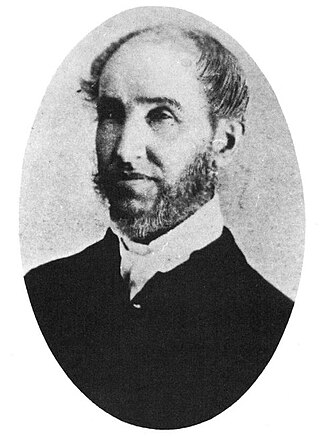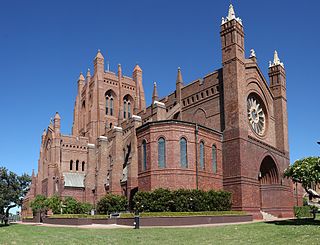
East Perth is an inner suburb of Perth, Western Australia, located next to the Perth central business district. Claise Brook and Claisebrook Cove are within the suburb. Formerly characterised by industrial land uses and urban blight, the redevelopment of East Perth was, and remains, the largest inner-city urban renewal project in the state. The design of the new residential neighbourhoods was strongly influenced by the new urbanism movement.

All Saints Church is an Australian Anglican Church in the Canberra suburb of Ainslie. The church is in the Anglican Diocese of Canberra and Goulburn. The parish holds to a liberal Anglo-Catholic style of churchmanship and theology.

The All Saints Church in Henley Brook is the oldest church in Western Australia. It was built by Richard Edwards between 1838 and 1840, with the first service taking place on 10 January 1841. The site is on a small hill overlooking the Swan River and near the conjunction of the Swan and Ellen Brook. This site was where Captain James Stirling camped during his 1827 exploration of the area.

William Mitchell was a Church of England priest who was the second ordained person, after Louis Giustiniani, to provide religious services in the Swan Valley area of the Swan River Colony. He worked in the Swan Parish for over 20 years before moving to Perth to take up a position working with convicts and prisoners in the Perth Gaol in Beaufort Street.

The Deanery is located on St Georges Terrace, at the intersection of St Georges Terrace and Pier Street, Perth, Western Australia.

Wesley Church is a Uniting Church in Perth, Western Australia, located at the corner of William Street and Hay Street. It is one of the oldest church buildings and one of few remaining 19th-century colonial buildings in the City of Perth.

The Cathedral Church of Christ the King, also called Christ Church Cathedral, is an Australian cathedral in Newcastle, New South Wales. It is the cathedral church of the Diocese of Newcastle in the Anglican Church of Australia. The building, designed by John Horbury Hunt in the Gothic Revival style, is located on a hill at the city's eastern end in the suburb called The Hill. It was added to the New South Wales State Heritage Register on 28 June 2011.

The English coastal city of Brighton and Hove, made up of the formerly separate Boroughs of Brighton and Hove in East Sussex, has a wide range of cemeteries throughout its urban area. Many were established in the mid-19th century, a time in which the Victorian "cult of death" encouraged extravagant, expensive memorials set in carefully cultivated landscapes which were even recommended as tourist attractions. Some of the largest, such as the Extra Mural Cemetery and the Brighton and Preston Cemetery, were set in particularly impressive natural landscapes. Brighton and Hove City Council, the local authority responsible for public services in the city, manages seven cemeteries, one of which also has the city's main crematorium. An eighth cemetery and a second crematorium are owned by a private company. Many cemeteries are full and no longer accept new burials. The council maintains administrative offices and a mortuary at the Woodvale Cemetery, and employs a coroner and support staff.

The St Jude's Church is an active Anglican church in Randwick, a suburb of Sydney, New South Wales, Australia. It is part of a significant heritage group that includes the church, cemetery, rectory and original Randwick Borough Chambers, later converted to church use. The group is located on Avoca Street, Randwick, and has a federal heritage listing. It was added to the New South Wales State Heritage Register on 2 April 1999.

St Matthew's Church is a heritage-listed Anglican church in Stirling Square, Guildford, Western Australia. The church is part of the Anglican Diocese of Perth.

Christ Church Tingalpa and Burial Ground is a heritage-listed former Anglican church at 1341 Wynnum Road, Tingalpa, City of Brisbane, Queensland, Australia. It was built from 1868 to 1993. It is now known as the Pioneer Wedding Chapel. It was added to the Queensland Heritage Register on 2 February 1998.
Charles Harper was Toodyay's first Anglican minister, and the first ordinand from Western Australia. While being a minister of the church was probably far from his intentions when he set sail for the Swan River Colony in 1837, his family's clerical background and his own disposition suited him well for this vocation. Harper served the Toodyay district for over 30 years, first as registrar of births, deaths and marriages, then from 1849 as an ordained minister.

St Patrick's Roman Catholic Cemetery is a heritage-listed closed cemetery on the corner of Pennant Hills Road and Church Street, North Parramatta, City of Parramatta, New South Wales, Australia. It is the earliest formalised Catholic cemetery in Australia, and was in use from 1824 to 1972. A central feature of this historic cemetery is the 1844 Gothic revival styled mortuary chapel, which is the oldest mortuary chapel in Australia. The cemetery was closed in 1972 and subsequently transferred to the City of Parramatta in 1975. It was added to the New South Wales State Heritage Register on 23 March 2012.

Holy Trinity Church is a heritage-listed Anglican church on the corner of Newcastle and Pool Streets, in York, Western Australia. The church was consecrated in 1858 by the first Anglican Bishop of Perth, Mathew Blagden Hale.

St Bartholomew's Anglican Church and Cemetery is a heritage-listed former Anglican church and cemetery at Ponds Road, Prospect, City of Blacktown, New South Wales, Australia. It was designed by Henry Robertson and built from 1838 to 1840 by James Atkinson. It was added to the New South Wales State Heritage Register on 2 April 1999. Since 1975, the site has been leased to the Council of the City of Blacktown.

St Peter's Anglican Church and Glebe Cemetery are a heritage-listed Anglican church and closed cemetery in East Maitland, New South Wales, Australia. The church is at 49 William Street while the cemetery is approximately 1.2 km (0.7 mi) away, approximately 400 m (1,312 ft) beyond the end of George St, also in East Maitland. The church was designed by Cyril and Arthur Blacket and built from 1884 to 1886. The cemetery is also known as Glebe Gully Burial Ground and Glebe Paddock. It was added to the New South Wales State Heritage Register on 31 August 2012.

St Paul's Anglican Church is a heritage-listed former Anglican church building and former bookshop at 346 Marsden Road, Carlingford, City of Parramatta, Sydney, New South Wales, Australia. It is also known as St Paul's Church of England and The Old Church Bookshop. It was added to the New South Wales State Heritage Register on 2 April 1999.

St Peter's Anglican Church is a heritage-listed Anglican church and associated Sunday school, rectory, and cemetery at 384 Windsor Street, Richmond, City of Hawkesbury, New South Wales, Australia. It was designed by Francis Clarke and Edmund Blacket and built from 1836 to 1841 by James Atkinson (church). It is also known as St Peter's Anglican Church Group, St Peter's Church Group, Church, Rectory, Church Yard, Cemetery and Stables. It was added to the New South Wales State Heritage Register on 16 August 2019; and on the City of Hawkesbury local government heritage register, and listed on the New South Wales Heritage Database on 12 September 2012.

St Mary's Anglican Church is a heritage-listed Anglican church in Peel Terrace, Busselton, Western Australia. It is possibly the oldest stone church in the state. Opened in 1845, and consecrated in 1848, it has been the subject of a number of additions, and has also been repaired or conserved on several occasions.
























